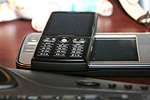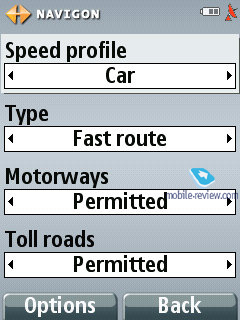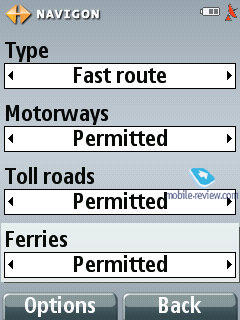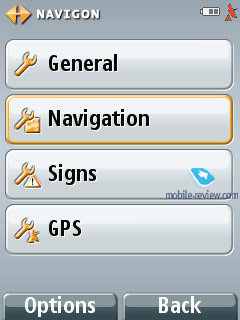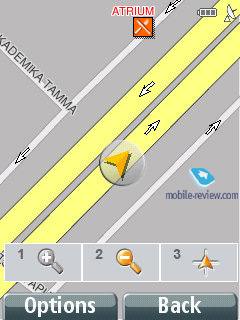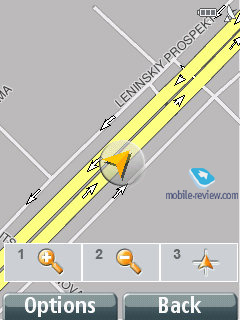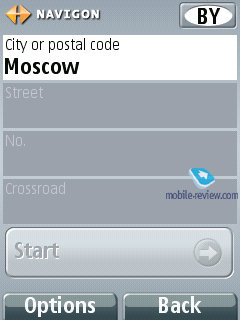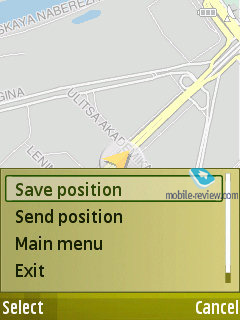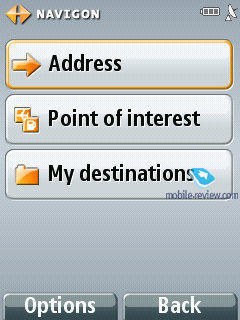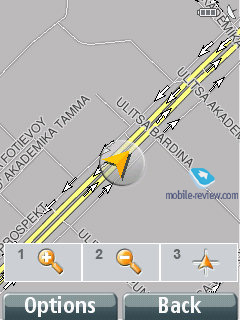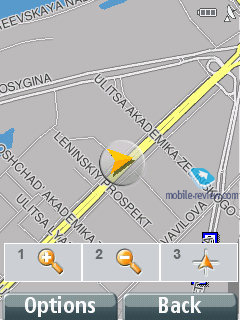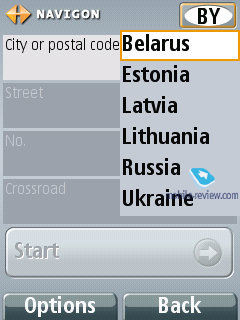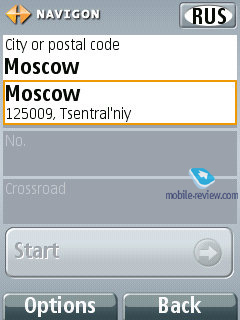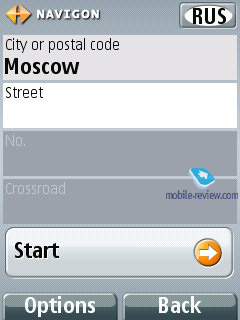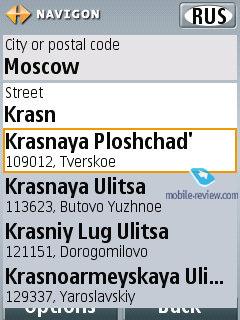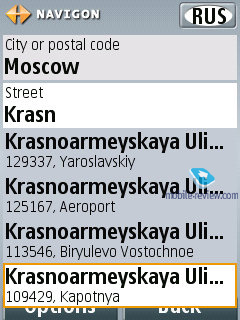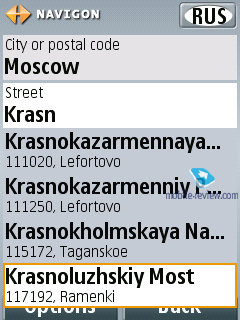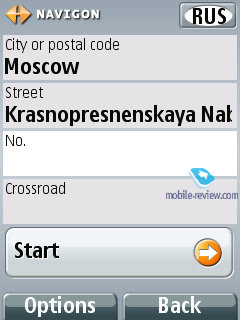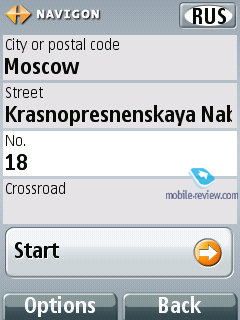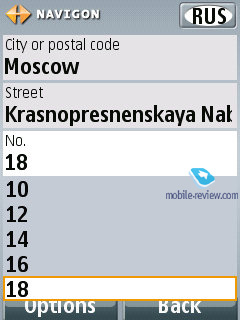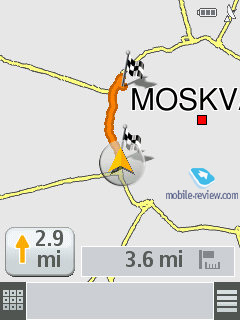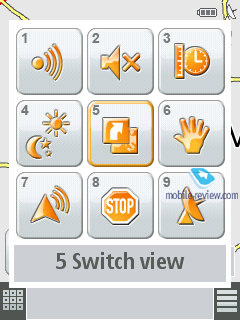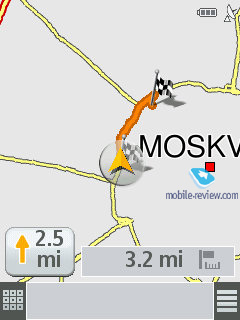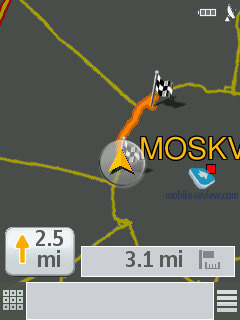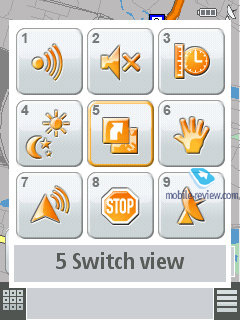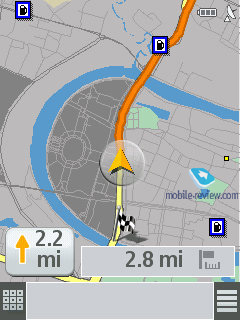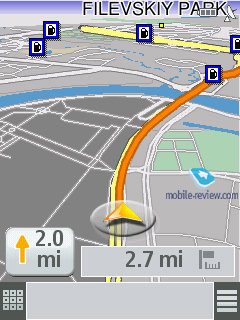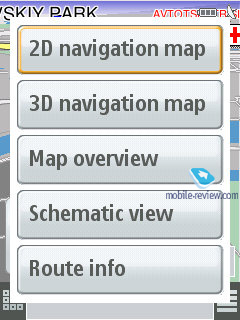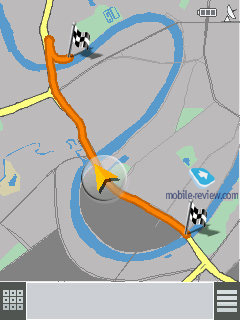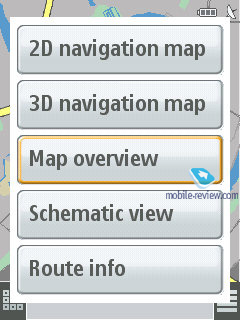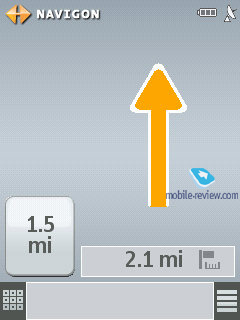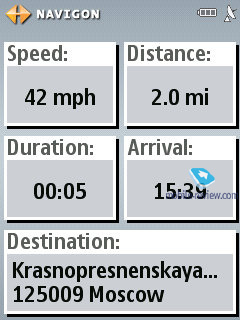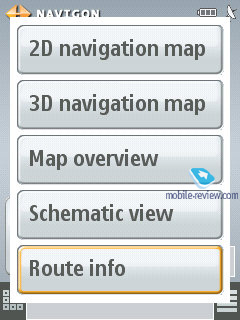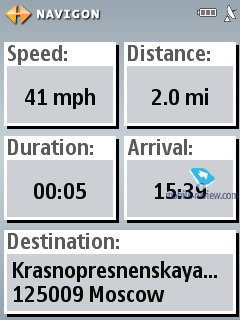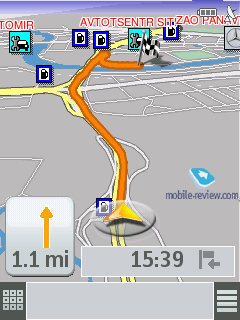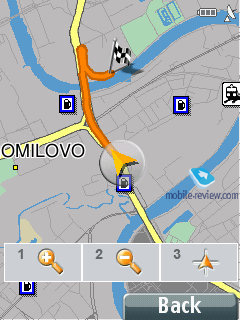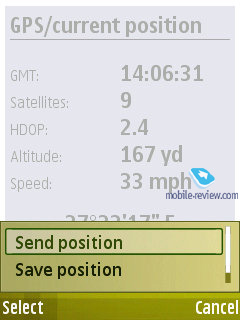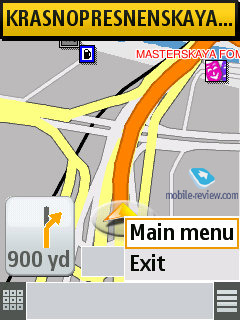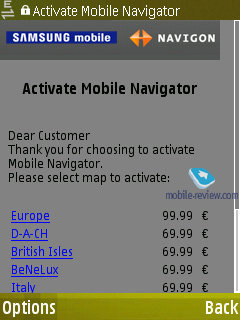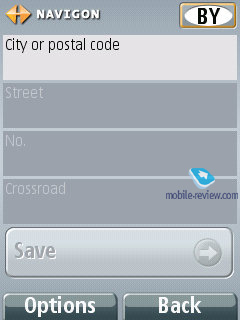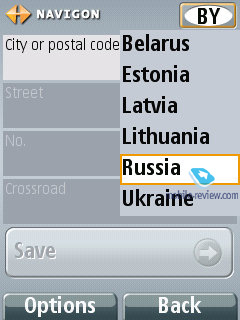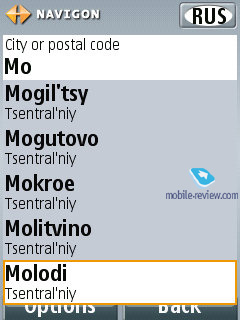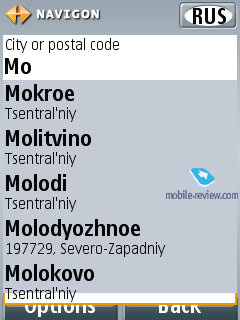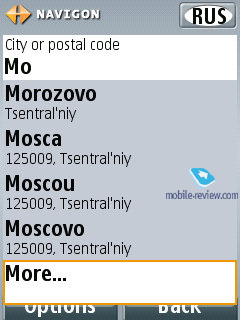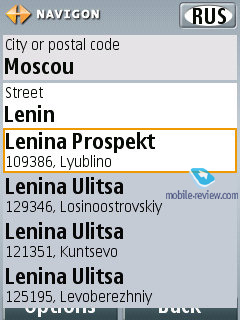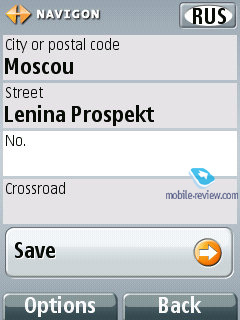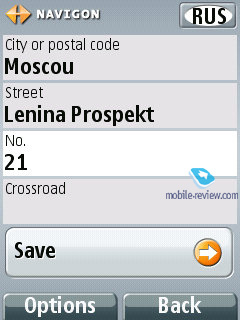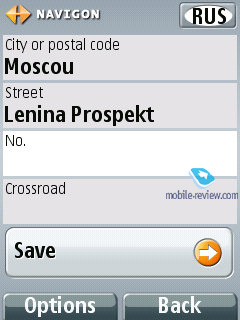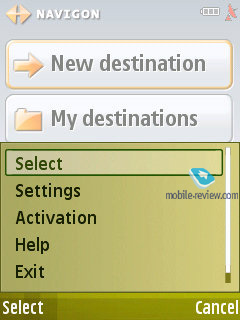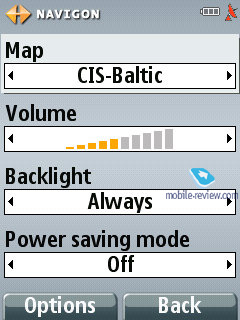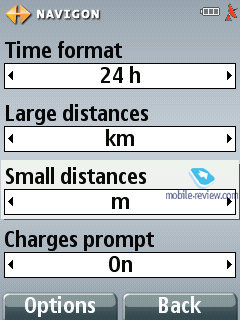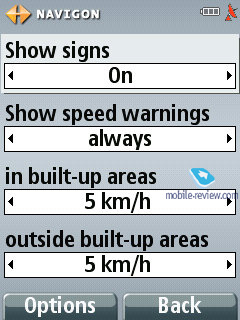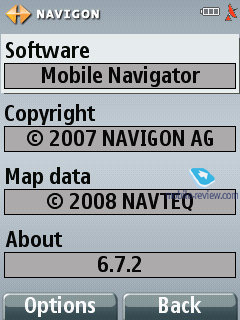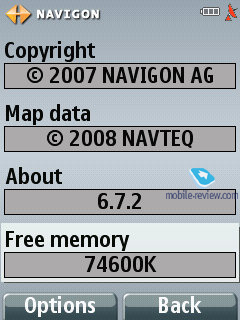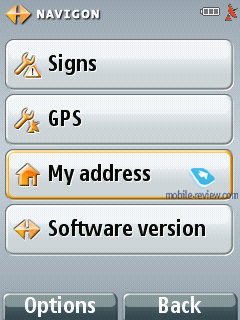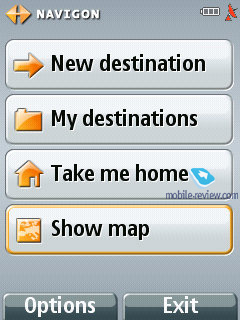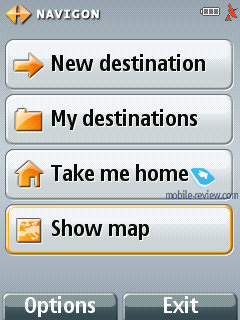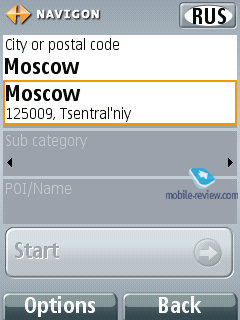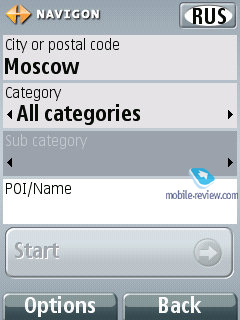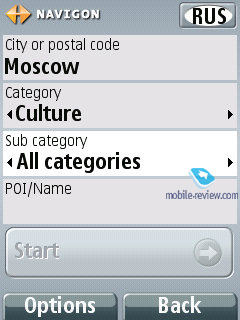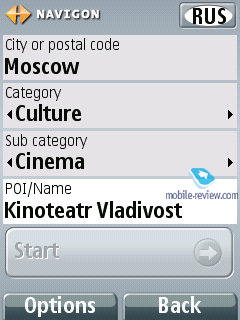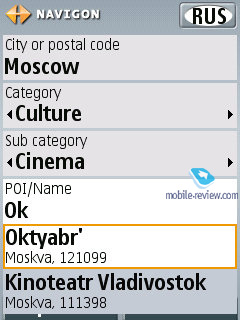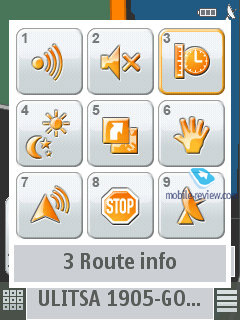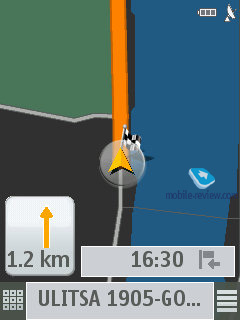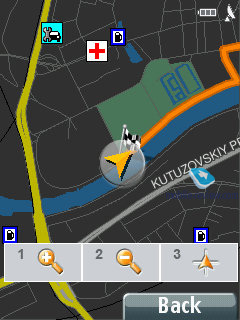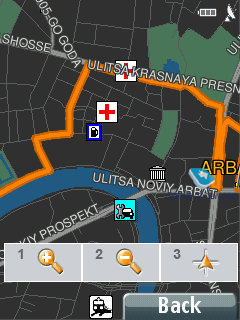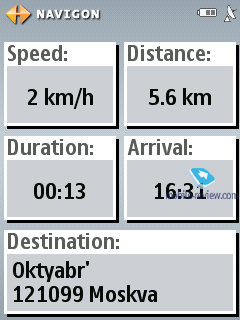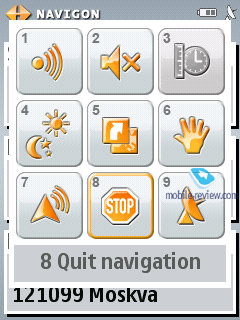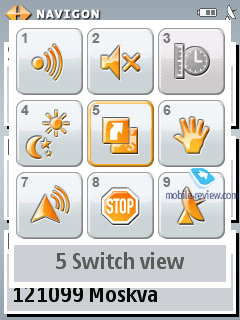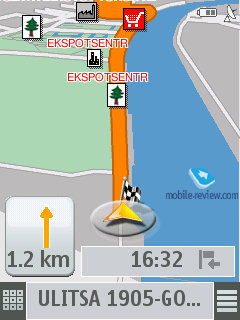|
|
Review of GSM/UMTS-handset Samsung i550
Live photos of the Samsung i550
Table of contents:
- Positioning
- Design, size, controls
- Display
- Keypad
- Hardware platform
- Performance
- Memory, memory cards
- USB, Bluetooth
- Battery
- GPS-navigation
- Music department
- Camera
- Preinstalled applications
- Impressions
Sales package:
- Handset
- Battery
- Charger
- Wired stereo-headset
- User Guide
- USB data cable
- 1 Gb microSD memory card (varies by region)
- Software CD
- DVD with Navigon software
Positioning
Samsung hasn’t gone any further than a couple of first steps in the segment of Symbian-based devices and, for now, is looking in the direction the carriers’ market. The situation for the company is actually twofold – while there is a bevy of carriers with custom packs of settings for the S60, on the other hand, there is the owner of the platform with a significant edge in this field – Nokia. And any maker wouldn’t be happy to have to roll out something all around unique or fill in the niches overlooked by Nokia.
Samsung picked the latter path and has been offering solutions in the price brackets where Nokia’s presence is nonexistent. For instance, the Samsung i400 was meant to be a mass-market device for carriers, whereas the Samsung i450 – a music-heavy phone striving to steal sales from the Nokia N81. Trying to win the hearts of consumers, Samsung banks on reasonably light price tags, but as I see it, this approach is not the right thing to do. There are no miracles in this world, and Samsung-branded solutions are just behind Nokia's phones functionality-wise simply because of the lack of experience in the field of software development. Naturally, they can always opt for boosting the hardware department by squashing more memory inside, crisper displays etc. But in general, there is very little, and let’s be honest if at all, room left for manoeuvres.
Another straw they are going to try to hold on to in an effort to settle in this segment is GPS, specifically two devices sporting this functionality onboard - the Samsung i550 and the Samsung i560. While they are tremendously different in terms of features, they start the line-up of GPS-enabled smartphones from Samsung. But these are nothing but a first go at the market, since similar solutions have always served for testing software and technologies. While these two are properly positioned price-wise, against the backdrop of Nokia-branded offerings, this won't save them either. All up, the i550 and the i560 are very niche solution with no direct competition in view of the spec sheets they offer.

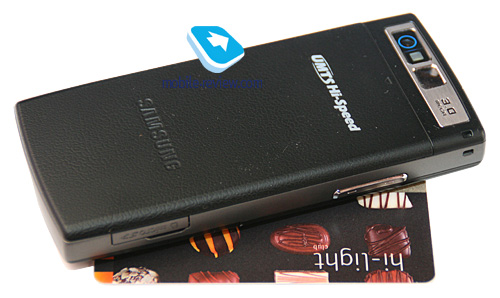
Now let’s try to work it out how might need GPS in Symbian-powered devices these days? Definitely, techi are keen on this functionality, but will their mouths keep watering when they find out there is no WiFi, in other words, that this is a model lacking the punch widely available with Nokia's solutions? Probably, not, what is more, consumers get more with Nokia-branded handsets right out of the box, like a better player, remote control and so on. The i500 doesn't seem to aim at the mass-market either, for it packs a couple of unique traits, like a quirky control – a trackball. It turns out that this is a device for techi, yet only few of them. And just like many other Samsung’s smartphones, the i550 is in for a small rise and then complete oblivion in the near future. Although it does sport some interesting features which we will cover below.
Back to the table of contents >>>
Design, size, controls
The model retains a candybar-style form-factor and measures up at 101x52x17.8 mm, tipping our scales at 110 grams. The i550 is quite palm friendly, doesn’t look very big, but still is somewhat on the tall side. Nevertheless, some may actually find it more convenient to handle this way. The handset comes only in Deep Black color scheme, where the spines employ dark-grey plastic, whereas the display framing enjoys glossy plastic type. The numberpad is made of matte black plastic. This mix of materials is pretty quaint, and thus the i550’s front fascia gets soiled in no time, while its rear doesn’t seem able to pick up a fingerprint.
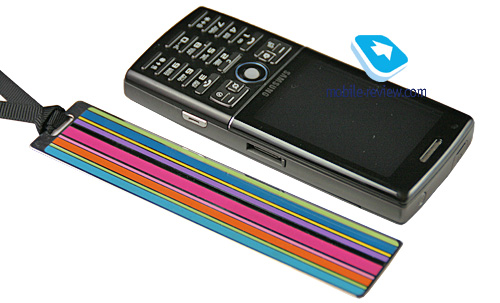

The battery compartment cover is styled in a leather-like fashion, and thanks to this, it will expose no scratches or scuffs, which is what we have seen on all Samsung's latest and greatest offerings.
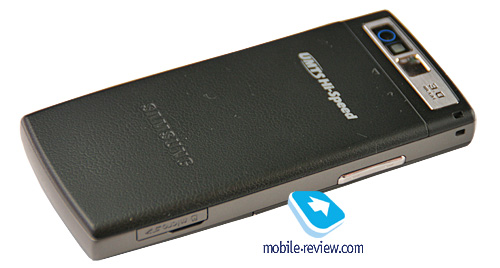
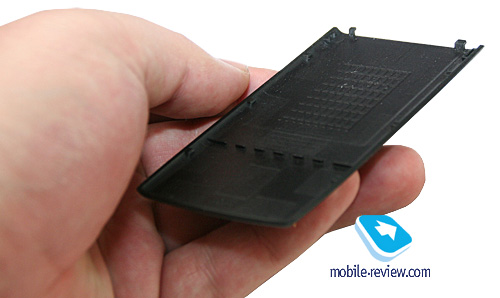
Topping the display is a front-facing camera for videoconferencing in 3G networks. The left-hand side houses the volume rocker below the lanyard eyelet. Also sitting on the left is the microSD memory expansion slot. Flipping over to the right flank you will find the interface connector, hidden under a sliding flap, and a dedicated camera button.
Mounted on the rear is the self-portrait mirror, LED flash and lens of a 3.2 Mpix camera.
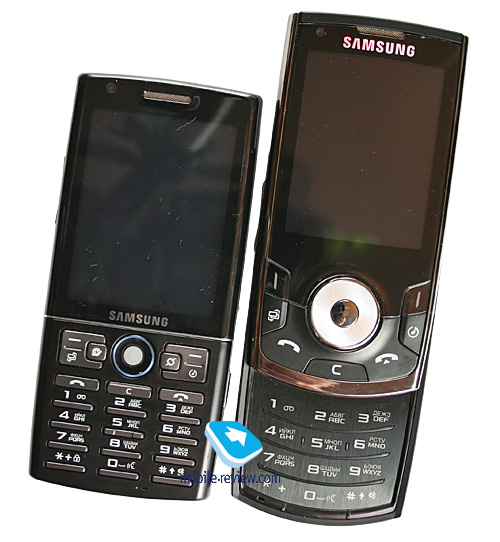
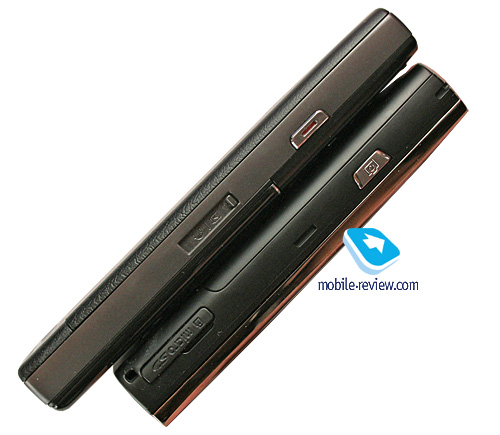
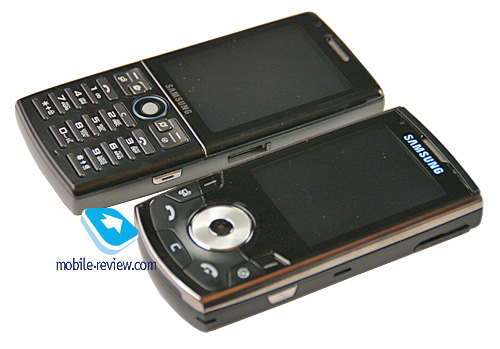
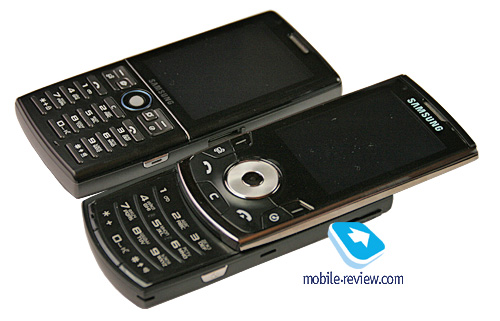
The i550 felt very robust in our hands, all parts and details seemed finely tweaked and tuned. One of the two samples we had our hands on had certain issues with the back cover - when we couldn't put it back in the slot in the right way and pressed on it, its legs bent a little and after that it felt somewhat loose. However, this has more to do with out carelessness, so don’t think of it as a real problem with the handset’s build quality.
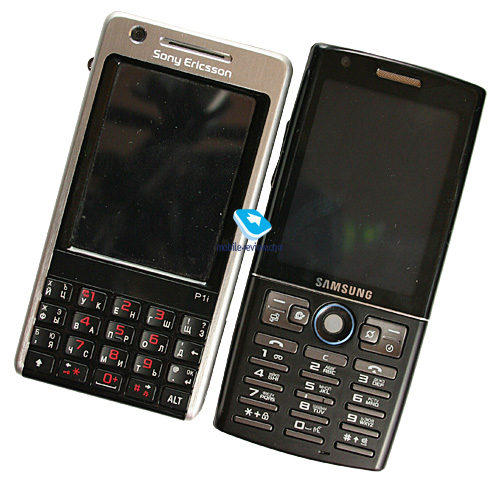

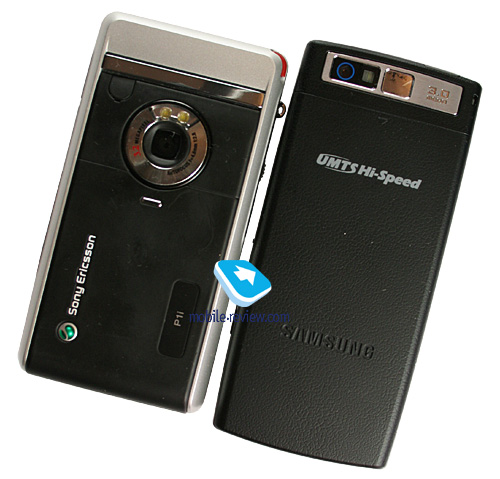
Back to the table of contents >>>
Display
The i550 utilizes a 2,6-inch TFT matrix offering you the resolution of 240x320 pixels (40x53 mm) and showing up to 262K colors in a juicy and vibrant picture. Compared to the Nokia N95, the i550’s screen appears to be a tad better thanks to being brighter and crisper than the former. And while it still gets washed out under direct sunlight, it remains perfectly legible.
The display accommodates up to 12 text and 3 service lines. Even with the default font size you will be able to get up to 16 lines of text in some modes.
Take a look at our face-off photos, where the i550 goes head to head with the Samsung i560, whose diagonal is smaller, and the truth is, despite all similarities there is a ton of things setting these two apart.



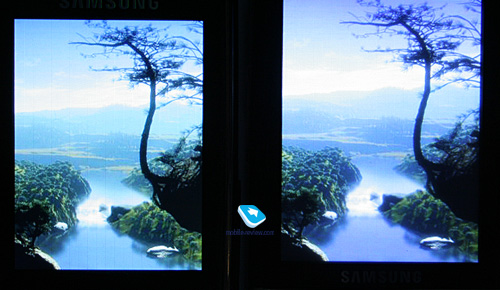
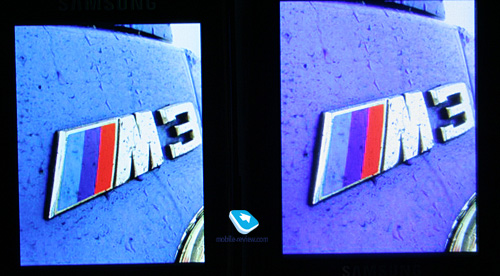
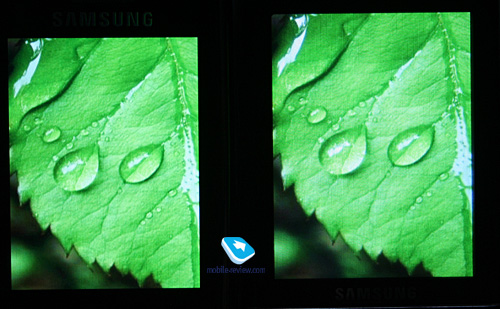
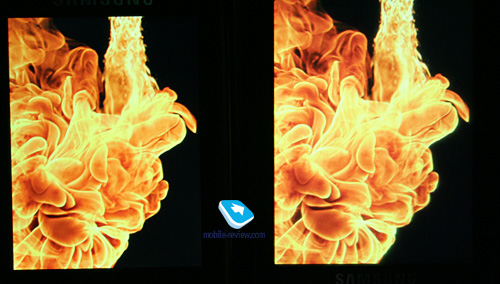
Back to the table of contents >>>
Keypad
The conventional numberpad is quite handy, being made of tiny rectangles with all key captions engraved in between. The i550 comes with no ambient light sensor.
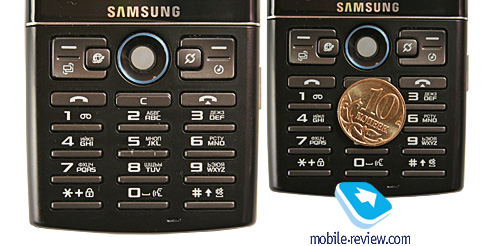

The cluster with functional keys has the Browser and the GPS buttons highlighted – the latter happens to trigger while the i550 is in your pocket, so we strongly recommend that you always lock the keypad. The good things about this, however, is that you can do so by holding the “*” button down. If you have locked the keypad, the display won’t spring back into life no matter what keys you press and to a certain extent it is one of its drawbacks, since it always remains dim.
The most unique control found in the i550, and the one replacing the standard joystick, is the trackball - this pointer device is familiar to many from some PCs, where it does the same job as the mouse, or notebooks. Using the settings you can tweak the trackball’s sensitivity to presses. The ball itself also retains a light indicator that glows in blue while in the standby mode and in red when the i550 is charging up.
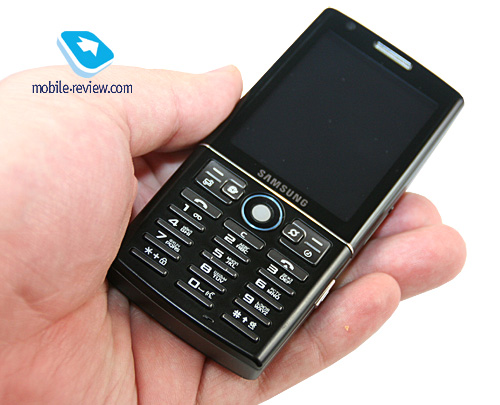
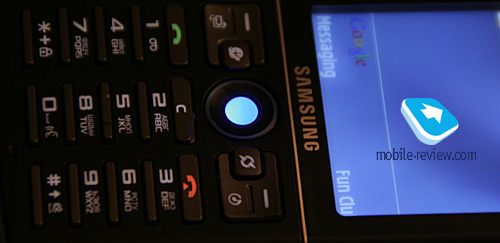
Managing the i550 with this trackball was not something we came to grips with instantly - we experienced misclicks, or, better to say, accidental transitions, for instance while in the Active Standby mode - we were paging through horizontally placed items, fingers shook a millimeter too much, and that was it, we moved on to the next item. So you will need some good accuracy to handle the i550 in a proper manner. While the smartphone's Web-browser seems to be the most logical place to employ the trackball, it is not all that easy - you will have to make use of the mini-map mode, otherwise scrolling through pages with the trackball will take too much time. Perhaps, the i550 would’ve been better off with a joystick, thankfully it does the job equally well, and the trackball is only interesting as long as it is an option. Around 10 years ago Nokia took a bunch of shots with similar trackballs embedded in mobile devices, but eventually dumped them. It seems, over at Samsung they are currently trying the same thing.
Back to the table of contents >>>
Hardware platform
This phone is interesting primarily for being very different from already bog-standard Nokia's S60 devices. Samsung is free to pick any solution it sees fit, that’s why the Samsung i550 is vastly different from any other S60-powered offering. Take, for example, its radio module based on the Qualcomm MSM6260, whereas Nokia doesn’t use it at all.
Unlike the Samsung i450, the i550 utilizes the TI OMAP 2430 chipset with bundled 2D/3D-accelerator, however we couldn’t find out which mode made any real use of it (probably it is engaged only in the camera app).
Since the smartphone department of the i550 and its radio part are driven by two different chips, this phenomenon has brought about a quite unusual solution, to be really specific, they have divided the phone's memory up in to stand-alone blocks. Essentially, the handset packages RAM for the radio module and the smartphone part (SRAM type for both, 32 Mb and 64 Mb respectively).
The i550's CPU (ARM1136) runs at 330 MHz.
Finally, it is time to take note of the IceMobile amplifier responsible for sound in this phone (works for headphones only, the sound you get from the i550’s loudspeaker is processed by TI’s built-in module). It turns out that this is only a deeply integrated solution, but that is hardly required in this very case. Of course it gets a tad bigger because of the variety of components (however the users will remain oblivious to this fact, since the i550's dimensions are perfectly okay), and generally hungrier for battery power (compared to single-CPU systems). However having dedicated modules and components do particular tasks gives all specs of the i550 a significant boost, in theory at lest. As you see, there are both pros and cons to either of the approaches.
Back to the table of contents >>>
Performance
As performance goes, we were thrilled to put the i550 head to head with the Nokia N95 – and the former turned out to be in line or even faster than the N95 in some ways, but generally they felt pretty much the same.
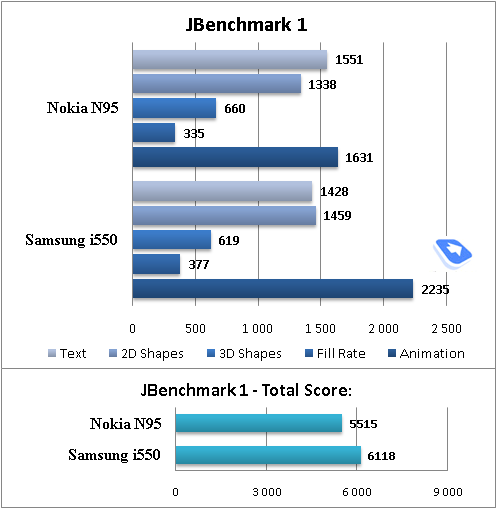
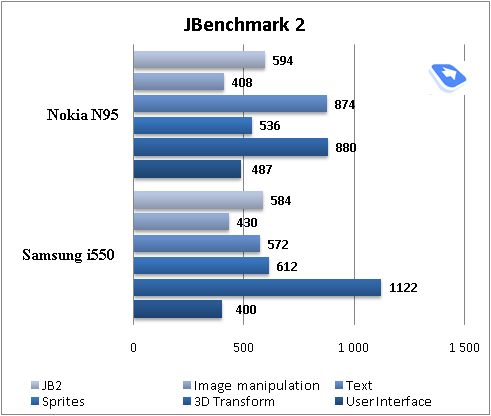
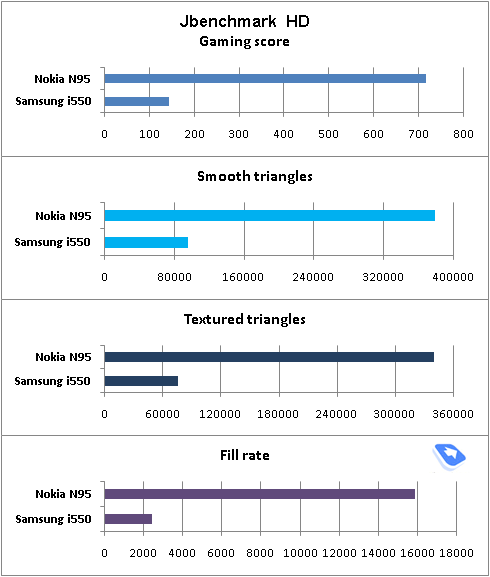
Back to the table of contents >>>
Memory, memory cards
The handset comes installed with 150 Mb of flash memory available to user, and 85 Mb of RAM (volume after first start up, no extra applications installed). The i550 handles microSD cards (hot-swappable) for bulking up the default storage (up to 2 Gb). Furthermore, the phone also managed to read 4 Gb units that we used with it during our tests.
Back to the table of contents >>>
USB, Bluetooth
USB. The handset comes in with USB 2.0 support, upon a successful PC connection you can choose one of the following modes:
- Data Transfer (Mass Storage USB) – memory cards is available, no drivers required, as your OS identifies the handset automatically. Data transfer speed makes around 2000 Kb/s (USB 2.0).
- PC Suite – used for device management via PC Suite, enables all features of the phone, data backup etc.
- PictBrigde – serves for printing images and photos.
- Media Player (MTP protocol) – synchronizes data with Windows Media Player.
Bluetooth. The smartphone sports EDR-enabled Bluetooth 2.0 alongside the following profiles:
- A2DP
- AVCRP
- BIP-ImagePush
- DUN-GW
- FT-Server
- HandsFree-AG (1.0)
- Headset-AG
- OBEX
- OPP-Client
- OPP-Server
- SIM Access-Server
The top speed you can get with the i550’s Bluetooth connection is around 100 Kb/s. We also tested its A2DP profile in pair with the Sony Ericsson DS970 headset, which worked just fine – we managed our play list, skipped within tracks and adjusted volume seamlessly, however we couldn’t make current track’s title show up on the i550’s display.
Back to the table of contents >>>
Battery
The i550 employs a higher-capacity battery - a 1200 mAh Li-Ion cell, which, as the manufacturer claims, can keep the handset up and running for 250 hours in standby and be good for 2,5 hours of talk time. In Moscow the phone lasted roughly 2 days at 5-6 hours of music and around an hour of calls (total), other features and abilities of the i550 were given short shrift. We also managed to squeeze 9,5 hours of pure music playback time out of it (bundled headphones, highest volume settings).
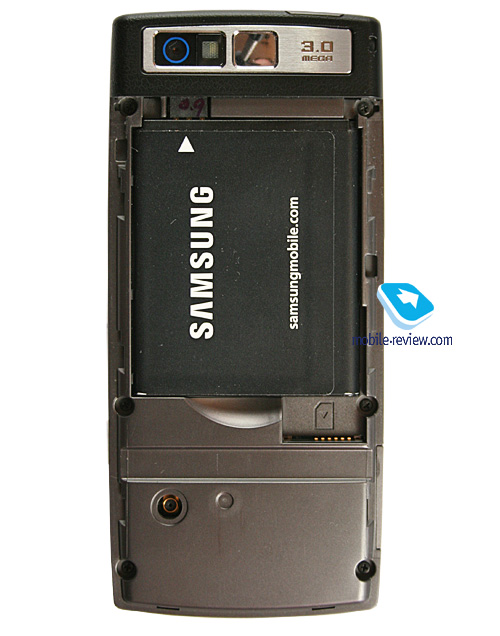
The GPS-navigation mode drains the battery clean in 2 hours 25 minutes, that’s while if you are intending to use it for in-car navigation, you better get a portable charger, otherwise using the i550 on the might may well become problematic.
Because of us hitting the dedicated navigation button by pure accident, the i550 would occasionally turn off after a day of use, as it got very power hungry in that mode. Full charging time – 2 hours, give or take.
Back to the table of contents >>>
GPS-navigation
Since the i550 runs the S60 platform, the first thing you expect of it is Nokia Maps or at very least Smart2Go inside, which is in fact the same application. However over at Samsung they have decided to bind their devices to only one app - for Symbian it is Navigon. This means you won’t be able to install Smart2Go on the i550, as there is no application with the required security certificate. We found only Google Maps 2.0 among all available programs that could actually deal with the bundled GPS receiver - nevertheless, we failed to make it work, as we were getting the "Searching for satellites” prompts for ten minutes straight and then a poor signal notification, and that was about it.
These issues aside, the i550 comes packaged with Navigon 6.27 or newer, however the end-user won’t notice any discernible differences between 6.xx versions. To make use of the handset’s navigation department, you will have to connect the i550 to a PC in the USB Mass Storage mode and then install both maps and the applications, which don’t come preinstalled with the phone, unlike Nokia-branded solutions. This is utterly inconvenient, so many may well overlook this step in the installation process and I have no idea how the maker could possibly turn a blind eye to this matter.
After getting the app and maps onboard, you can manually pick a file with voice tips and directions (Russian also available), but again, it is all manual, so this is another letdown to the i550’s software.
Basically, all those familiar with S60 applications and how they have to be installed, the i550 will be an easy walk, but all novices will run into certain difficulties.
We are happy that the handset features a dedicated button for launching the GPS application - you jump right into its home screen (which is not the map). It is in fact very different from Nokia Maps and we can't call it comfortable to use by any means. Firstly, it is not a full version that you get along with the i550 - all you get is a two-week trial, and then to employ voice tips and route calculation features you will have to pay around 60 Euro. For instance, Nokia offers free route calculation, but charges for voice functions and navigation.
Secondly, having entered the map mode you will see that the device starts trying to find satellites, meaning that you won’t be able to view the map or do anything else without having your location tracked. And it is hard to say how much does this thing hamper the application’s ergonomics – for instance, you can’t calculate a route from A to B when the battery is low. I, for one, think it is one illogical and crippled way to build the application.
Another thing of note about the maps is that all locations are given in transliteration, although the interface can be switched to Russian. The map of Moscow seemed to be fairly detailed for every day use, although had no bells and whistles, being in line with Nokia Maps or a inbuilt car navigator. The i550’s voice for directions sounds loud, but what we are really concerned about is that there is no car cradle, which made us throw it on the dashboard, where the display wasn't really visible.
The navigation mode drains the battery in no time – to be more specific, in around 2 hours. The good thing about the i550's GPS is that the cold start time in car makes 5 minutes or so – after linking up to the satellites, the handset never loses the signal and offer fairly good positioning accuracy.
Among the application’s screaming letdowns is that you can't zoom in and out on the map in real time - you will need to enter the menu first. Other abilities of the app include 2D/3D-graphics, night mode, but these are no bells and whistles.
The POI search with the i550 is nothing out of the ordinary – we found the number of points provided quite okay for Moscow, albeit not great. For example the navigator missed a couple of gas stations we drove past when we asked it to give us the nearest station, so it seems the database is the most comprehensive out there.
Routes can be calculated with speed and other limits, nothing to shout about, though. The route simulation mode, however, seemed nowhere to be found, which somewhat puzzled us.
Undoubtedly, we could turn this rundown of the i550’s GPS department into a lengthy write-up, but we don’t see any point in doing so. The fact of the matter is that Navigon is not the best offering available in this class, as it comes with a truckload of limitations, two of which are critical, so this is why are not going to focus on it in particular. Take a look at the interface snapshots; I guess they will do the talking from this point on.
Back to the table of contents >>>
Music department
The i550 packages a typical S60 player with no extra options or plugins tacked on, not even a single equlizer. And the reason doesn’t take a rocket scientist to figure out – they dumped them in this phone so as not to put it up against the Samsung i450, since these two are very resembling sound quality-wise and technically the Samsung i550 outputs slightly more natural sound. I won’t make any secret of this – I was extremely pleased to bump into this level of sonic experience in this device (as well as in the i450 and the i560, basically these three are very good at music quality).
However software-wise the i550 is quite bare, and extra options aside, it doesn't even have a remote control. All up, we doubt you will have comfortable music sessions with this phone.
Alexander Dembovsky’s take on the i550. The i550’s headphone jack and a fairly good audio section design had a very positive impact on its performance in the tests. As the diagram suggests, its lows are slightly down, while the highs don’t seem to be evened out. As for the rest, the Samsung i550 is a very good performer with all its figures and marks almost exactly the same as those of the i450 known for its music prowess. The Samsung i550 will have to do without equalizers, although it doesn’t seem to be that much of a loss in my opinion – the handset still can render music as well as the MP3 format can only allow, and what is more, the i550 ships with a pair of fairly good headphones.
Rounding out this array of musical merits are the noise and IMD values, which are unexpectedly good for a phone - any dedicated music player wouldn't mind having these results.
General performance
| Frequency response (from 40 Hz to 15 kHz), dB: |
+0.40, -0.68 | Average |
| Noise level, dB (A): |
-88.6 | Good |
| Dynamic range, dB (A): |
85.8 | Good |
| THD, %: |
0.0028 | Excellent |
| IMD, %: |
0.043 | Good |
| Stereo crosstalk, dB: |
-89.0 | Excellent |
| Intermodulation at 10 kHz, %: |
0.029 | Good |
General performance: Good
Frequency response

Noise level

General performance - Samsung i550 versus Samsung i450
| Criteria |
Samsung i550 |
Samsung i450-2 |
| Frequency response (from 40 Hz to 15 kHz), dB: |
+0.40, -0.68 | +0.41, -1.38 |
| Noise level, dB (A): |
-88.6 | -85.4 |
| Dynamic range, dB (A): |
85.8 | 84.4 |
| THD, %: |
0.0028 | 0.0024 |
| IMD, %: |
0.043 | 0.032 |
| Stereo crosstalk, dB: |
-89.0 | -87.7 |
Frequency response – Samsung i550 versus Samsung i450

Noise level – Samsung i550 versus Samsung i450

FM radio – this application sports standard interface, with the ability to save up to 20 stations. When tested in city, the radio worked in its usual way. No auto-tuning is available with the i550, so that you will have to find all stations manually.
Back to the table of contents >>>
Camera
The i550 comes armed with a 3.2 Mpix CMOS matrix, measuring ? inches from corner to corner and packing autofocus for good measure. All thanks to the chipset it runs on, the phone’s camera snaps better shots then similar solutions, like the Samsung D900/D900i.
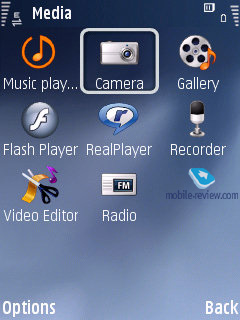
There are three picture quality levels available, as well as the following resolutions:
- 2048x1536;
- 1600x1200;
- 1152x864;
- 800x600;
- 640x480;
- 320x240;

Among unusual settings we spotted on the i550, there is the ability to disable auto focus, which comes in handy on certain occasions. Sadly, there is no macro mode embedded in the handset, unlike other Samsung-branded models.
The rest of the settings pool is nothing to shout about: white balance, a couple of effects (Normal, Sepia, Black&White, Negative, Aqua), etc. The i550’s LED flash is no help at all most of the time, although on a rare occasion it can lighten the things up.

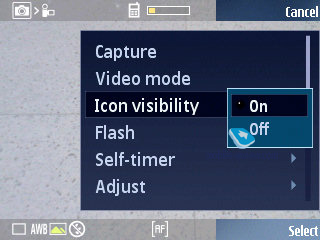
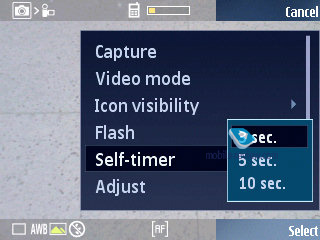
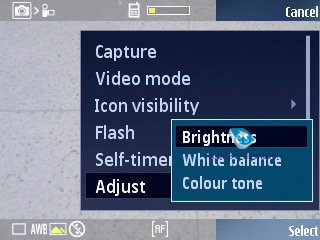
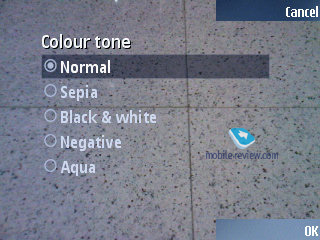
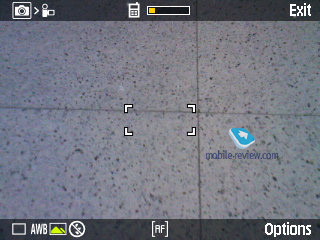
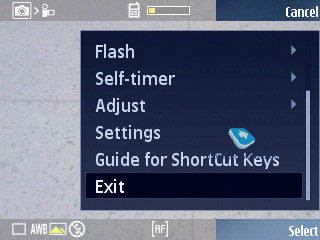
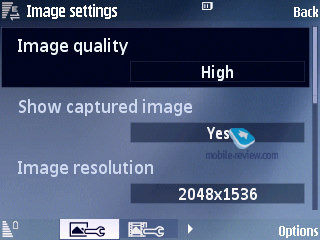

From the samples below it is easy to see that the camera fares well for the most part, and this is definitely not the last thing going for the i550.
 |
 |
| (+) maximize, 2048õ1536, JPEG |
(+) maximize, 2048õ1536, JPEG |
 |
 |
| (+) maximize, 2048õ1536, JPEG |
(+) maximize, 2048õ1536, JPEG |
 |
 |
| (+) maximize, 2048õ1536, JPEG |
(+) maximize, 2048õ1536, JPEG |
 |
 |
| (+) maximize, 2048õ1536, JPEG |
(+) maximize, 2048õ1536, JPEG |
 |
 |
| (+) maximize, 2048õ1536, JPEG |
(+) maximize, 2048õ1536, JPEG |
 |
 |
| (+) maximize, 2048õ1536, JPEG |
(+) maximize, 2048õ1536, JPEG |
 |
 |
| (+) maximize, 2048õ1536, JPEG |
(+) maximize, 2048õ1536, JPEG |
 |
 |
| (+) maximize, 2048õ1536, JPEG |
(+) maximize, 2048õ1536, JPEG |
Video. You can capture video in two resolutions – 352x288 and 176x144 pixels at 15 FPS (sound may be disabled). The quality you get with the i550 is not mind-blowing, basically your clips will look fine on the phone’s display, but won’t be as good on a PC screen.



Back to the table of contents >>>
Preinstalled applications
The handset doesn’t come preinstalled with a host of applications. The standard suite only includes Adobe PDF, QuickOffice for reading documents (you can edit them as soon as you buy the program’s full version).
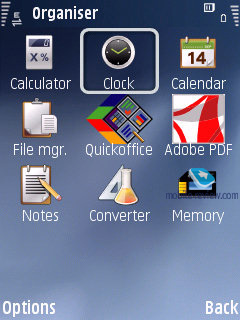
Flash Player – allows opening flash clips outside the bundled browser, packed by the i550 as a stand-alone application
Voice Signal – a voice recognition package, one of the market’s finest as of today. While at the standby screen you can call up voice commands by tapping and holding “0”. With this application you can dial a number from your contact book, bring up some menu items and other commands. No prior voice training is required, the handset assumes your current menu language for the needs of this app. Compared with a similar app from Nokia, found in its smartphones, this package is well superior and on top that makes fewer mistakes when dialing a number.
Video editor
Another application that goes beyond the standard suite of features found in Nokia’s S60-based phones. There are three modes available with this Video editor – the first and the least sophisticated one allows you to edit video clips (clip length, start time, sound track, sound recording etc).
The second mode is more a valuable addition to the default functionality of the system. With a bunch of photos on your hands, you can create a CIF, QVGA or QCIF clip. In a word, you pick all photos you will need, set the background music and then tweak transition effects. There is a multitude of options available in this mode, but it doesn’t get too complicated – on the contrary, everything is pretty intuitive. Naturally, you will need some skills and taste for this, but it’s worth your time. And this is by no means a replacement for the slide-show mode, you just get a short video that can be shared right away.
The last mode you can find in this Video editor is ‘StoryBoard’, that is quite similar to the previous one, however here you can throw photos and video into your clip. All other settings have been left intact.
Back to the table of contents >>>
Impressions
The volume level produced by the loudspeaker is pretty high, being in line with those Nokia-branded smartphones equipped with stereo-speakers. We also liked the i550’s solid vibro alert. In terms of voice calls and microphone sensitivity, its performance is up to par, nothing that we would whine about.
The handset starts shipping early in January for 350-400 Euro (in Europe). So, what do we get for this money? A fairly good smartphone with somewhat quirky ergonomics, specifically, we were somewhat confused about the trackball. It also packs a decent camera, which, however, pales in comparison to the competition - for instance, the Nokia N82 sports a 5 Mpix unit with a top-notch lens, xenon flash and GPS thrown in for good measure.
If we were to image some rival for the Samsung i550, it would be the Nokia N82 – it comes with all the making of one, including its in-built GPS. It is quite another matter, though, that even with its slightly heftier price tag, the N82 is a more preferable option.
The i550 is nothing but a feeler – some will find it pleasant, but there won’t be many of this breed. Unfortunately, the player's fair sound quality is negated by its software department, and the lack of Wi-Fi puts it behind the vanguard of similar solutions. All up, the Samsung i550 is in a league of its own, and won't really appeal to the mass market. Although, as a proving ground for some technologies, it has all the rights to exist.
Related links:
Back to the table of contents >>>
Eldar Murtazin (eldar@mobile-review.com)
Translated by Oleg Kononosov (oleg.kononosov@mobile-review.com)
Published — 10 January 2008
Have something to add?! Write us... eldar@mobile-review.com
|
News:
[ 31-07 16:21 ]Sir Jony Ive: Apple Isn't In It For The Money
[ 31-07 13:34 ]Video: Nokia Designer Interviews
[ 31-07 13:10 ]RIM To Layoff 3,000 More Employees
[ 30-07 20:59 ]Video: iPhone 5 Housing Shown Off
[ 30-07 19:12 ]Android Fortunes Decline In U.S.
[ 25-07 16:18 ]Why Apple Is Suing Samsung?
[ 25-07 15:53 ]A Few Choice Quotes About Apple ... By Samsung
[ 23-07 20:25 ]Russian iOS Hacker Calls It A Day
[ 23-07 17:40 ]Video: It's Still Not Out, But Galaxy Note 10.1 Gets An Ad
[ 19-07 19:10 ]Another Loss For Nokia: $1 Billion Down In Q2
[ 19-07 17:22 ]British Judge Orders Apple To Run Ads Saying Samsung Did Not Copy Them
[ 19-07 16:57 ]iPhone 5 To Feature Nano-SIM Cards
[ 18-07 14:20 ]What The iPad Could Have Looked Like ...
[ 18-07 13:25 ]App Store Hack Is Still Going Strong Despite Apple's Best Efforts
[ 13-07 12:34 ]Infographic: The (Hypothetical) Sale Of RIM
[ 13-07 11:10 ]Video: iPhone Hacker Makes In-App Purchases Free
[ 12-07 19:50 ]iPhone 5 Images Leak Again
[ 12-07 17:51 ]Android Takes 50%+ Of U.S. And Europe
[ 11-07 16:02 ]Apple Involved In 60% Of Patent Suits
[ 11-07 13:14 ]Video: Kindle Fire Gets A Jelly Bean
Subscribe
|


